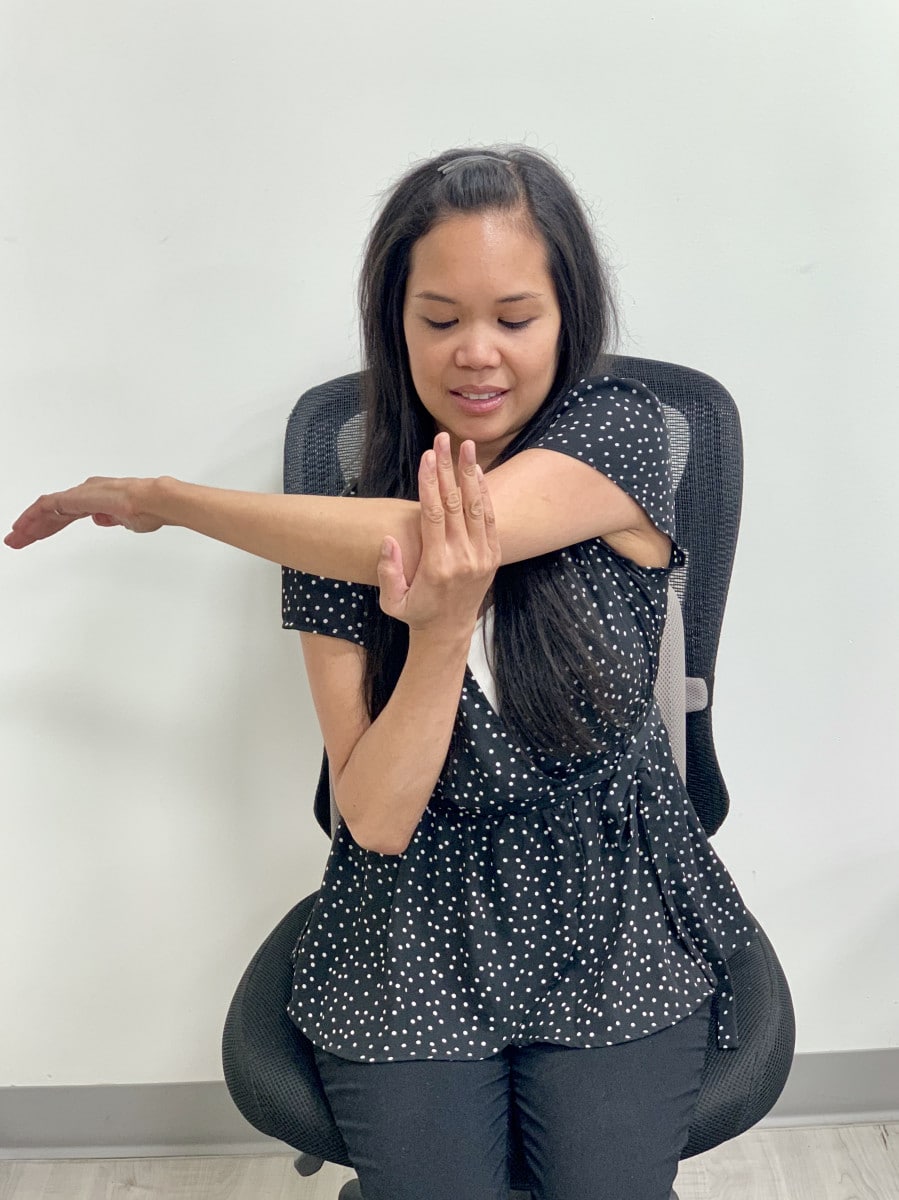As discussed in the June 2019 blog, we spoke about how to sit at a desk job with proper posture. Having poor posture while working can contribute to aches and pains throughout your whole body. What if your job requires you to sit for 8 hours at a desk? The answer is… STRETCHING! It’s also important to make sure you’re getting out of your chair at a minimum of once every hour, in addition to stretching.
What are the benefits of incorporating stretching into your work day?
- Decreases stress (personal or work)
- Decreases tightness in your muscles
- Decreases the risk of repetitive strain injuries
- Prevents loss of mobility
- Increases work productivity
- Increases your flexibility
- Maintains proper blood flow to your muscles and tissues
- Improves balance and posture
What stretches are appropriate for work?
- The suggested stretches below are broken down into different parts of the body. For each stretch, hold for 10 seconds on each side and repeat as necessary.
BACK/NECK:
- Sitting for prolonged periods of time can leave the back and neck feeling tight and achy. While working on the computer most of us will drop our head forward, putting more stress on the neck muscles. Having this tension all day long can lead to headaches. Here are some general stretches that can be performed at your desk:
- The Twist: Sit in your chair with your feet flat on the floor. Cross one leg over the other, take the opposite arm to your knee and twist towards the open side. Don’t go too far, you only need a little rotation to feel the stretch. Hold this position for 10 seconds, then repeat with the opposite side.
- Neck Rotations: Sitting in your chair, keep your head upright. Gently turn your head to the left and feel the stretch down the right side of your neck and shoulder. Try to move your head past your shoulder as you turn. Hold this position for 10 seconds, then repeat on the opposite side.
- Back Extensions: Sit straight with your feet together. Place the palms of your hands on the lower portion of your back with your fingers pointing down. Lean back over your hands. You will feel a stretch in your lower back. Hold this position for 10 seconds.
- Prayer Stretch: Place your palms together with your fingertips pointing upwards. Slowly bring your hand down until you feel a stretch in your wrists. Hold this position for 10 seconds.
- Reverse Prayer Stretch: Keeping your palms together, point your fingers downwards. Slowly bring your hands up until you feel a stretch in your wrists. Hold this position for 10 seconds.
UPPER EXTREMITY:
- Working a job that requires you to be on the computer all day causes stress and tension to the upper extremity. Having to repetitively type and click all day can contribute to issues such as carpal tunnel, tendonitis and/or trigger fingers just to name a few. Here are some general stretches you can perform at your desk to prevent repetitive strain injuries:
- Posterior Shoulder Stretch: Bring one arm across your body. Pull your elbow into your chest using the opposite hand. You will feel a gentle stretch in your shoulder. Hold for 10 seconds on each side.

|
- Scapular Squeezes: In a seated position, keep your elbows bent at your side at about 90 degrees. Pull your elbows back as your squeeze your shoulder blades together. Hold for 5 seconds. Then let them slowly relax. Repeat 8-10 times.
LOWER EXTREMITY:
- Sitting at your desk all day can also cause tightness and limited mobility to your muscles from the hips down. It’s important to make sure you’re stretching your lower extremities to prevent tension to your back muscles as well. Here are some general stretches that you can perform at your desk:
- Seated Hip Stretch: From a seated position, bring your right ankle up and cross it over your left knee. Make sure you are sitting up tall, then gently lean forward. Remember to keep your back straight, leaning forward until you feel a stretch in your hip and glute. Hold for 10 seconds and then repeat on the opposite side.
- Hamstring Stretch: While sitting, extend one leg out straight. Reach your arm down toward your toes while maintaining a straight back. Feel the stretch in the back of your leg. Hold for 10 seconds and then repeat on the opposite side.
- Ankle Rotations: While sitting, rotate your ankles in a clockwise direction for 5 seconds. Repeat the motion in a counter-clockwise direction. Repeat 8-10 times on each side
When To Take A Break?
We’ve covered some easy stretches you can do at work right at your desk in this post. We’d also like to mention it’s important to give your eyes a break from looking at your computer screen. Every 20 minutes or so, look out into the distance for 20 seconds. The reorientation will lessen the strain on your eyes and can help prevent headaches.
Performing the above suggested stretches along with taking a short pause by standing up every 30 minutes or so will help reverse the daily stresses of your workplace setting.
If you’re looking for a more personalized stretch plan based on your particular job demands or if you have any previous injury or pain with performing any of these stretches, consult with your occupational and/or physical therapist.
Happy stretching!
Erin Klimkowski, MS, OTR/L
#stretching #occupationaltherapy #physicaltherapy #teamcynergy #cynergyphysicaltherapy #painprevention #repetitivestraininjury #we💜healingourpatients
